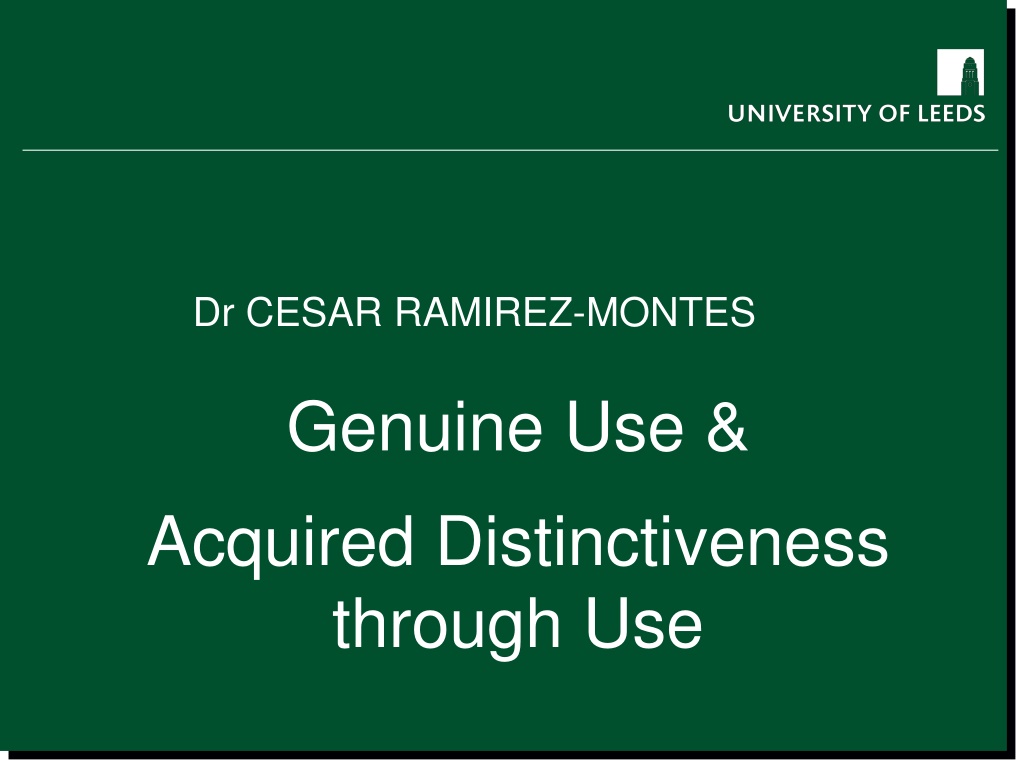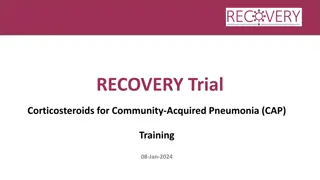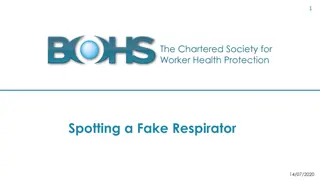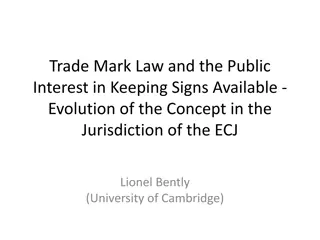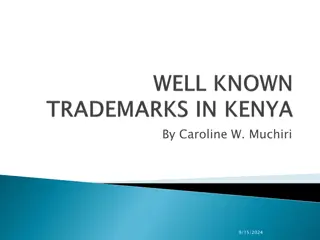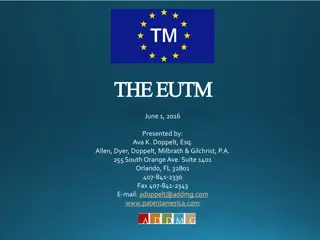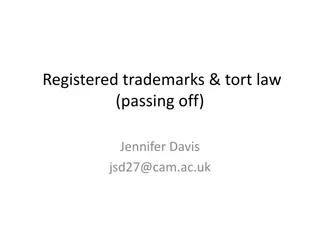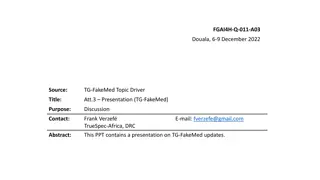Understanding Genuine Use and Acquired Distinctiveness in Trademarks
Exploring the concept of genuine use and acquired distinctiveness in trademarks, this content delves into the general principles and specific regulations in the EU, UK, France, and Germany. It discusses the importance of maintaining continuous use of a trademark and the consequences of non-use, as well as the criteria for proving genuine use in opposition proceedings. Key articles such as Art. 15 CTMR and Art. 42(2) CTMR are highlighted, emphasizing the requirements and implications for trademark owners. Additionally, the content touches upon the significance of use in maintaining trademark rights and protecting against non-use sanctions.
Download Presentation

Please find below an Image/Link to download the presentation.
The content on the website is provided AS IS for your information and personal use only. It may not be sold, licensed, or shared on other websites without obtaining consent from the author. Download presentation by click this link. If you encounter any issues during the download, it is possible that the publisher has removed the file from their server.
E N D
Presentation Transcript
School of something FACULTY OF OTHER Dr CESAR RAMIREZ-MONTES Genuine Use & Acquired Distinctiveness through Use
OUTLINE Genuine Use of a TM: General principles; Acquired Distinctive Character through Use: General Principles EU UK France Germany
School of something FACULTY OF OTHER Genuine Use of a TM
Art.15 CTMR: (1) the proprietor has not put the Community trade mark to genuine use in the Community in connection with the goods or services in respect of which it is registered, or if such use has been suspended during an uninterrupted period of five years, the Community trade mark shall be subject to the sanctions provided for in this Regulation, unless there are proper reasons for non-use. (2) The following shall also constitute use within the meaning of paragraph 1: (a) use of the Community trade mark in a form differing in elements which do not alter the distinctive character of the mark in the form in which it was registered; If, within a period of five years following registration,
Art. 42(2) CTMR: If the applicant so requests, the proprietor of an earlier Community trade mark who has given notice of opposition shall furnish proof that, during the period of five years preceding the date of publication of the Community trade mark application, the earlier Community trade mark has been put to genuine use in the Community in connection with the goods or services in respect of which it is registered and which he cites as justification for his opposition, or that there are proper reasons for non-use, provided the earlier Community trade mark has at that date been registered for not less than five years. In the absence of proof to this effect, the opposition shall be rejected. If the earlier Community trade mark has been used in relation to part only of the goods or services for which it is registered it shall, for the purposes of the examination of the opposition, be deemed to be registered in respect only of that part of the goods or services. Art. 42(3) CTMR Paragraph 2 shall apply to earlier national trade marks referred to in Article 8(2)(a), by substituting use in the Member State in which the earlier national trade mark is protected for use in the Community.
Art. 10 TMD: If, within a period of five years following the date of the completion of the registration procedure, the proprietor has not put the trade mark to genuine use in the Member State in connection with the goods or services in respect of which it is registered, or if such use has been suspended during an uninterrupted period of five years, the trade mark shall be subject to the sanctions provided for in this Directive, unless there are proper reasons for non-use. The following shall also constitute use within the meaning of the first subparagraph: (a) use of the trade mark in a form differing in elements which do not alter the distinctive character of the mark in the form in which it was registered; (b) affixing of the trade mark to goods or to the packaging thereof in the Member State concerned solely for export purposes.
International Sources Art.5(1) and (2) of Paris Convention 1883 Countries of the Union may require use of the registered mark and, in the absence of it, may order cancellation but only after a reasonable period and only if no reason for non-use are offered;
General Principles There s no de minimis rule applicable to the territorial scope of the use (Leno Merken); the territorial borders of the MSs should be disregarded in the assessment of whether a trade mark has been put to genuine use in the Community (Leno Merken); Whilst it is reasonable to expect that a Community trade mark should be used in a larger area than a national mark, it is not necessary that the mark should be used in an extensive geographic area for the use to be deemed genuine (Leno Merken) The use must accord with the essential function of the mark and for the purpose of creating an outlet for the goods in question. The concept of genuine use of a CMT in the EU is exhaustively and exclusively governed by EU law (BASKAYA); Genuine use is governed by the principle of unitary character of a CTM, namely uniform protection with effects in the entire area of the Community. This principle is however not absolute (BASKAYA)
The fact that the goods are offered on a non-profit- making basis doesn t necessarily mean the use by a charity of a mark cannot be genuine (Verein Radetzky- Orden); The question re the territorial aspect of the use of earlier marks is exhaustively governed by Community law,, whether it be a Community, national or international mark (BASKAYA); Although the concept of genuine use ensures that the raison d etre of the mark isn t lost, EU law allows the proprietor to make variations in the way he exploits the mark commercially which, without altering its distinctive character, enable it to be better adapted to the marketing of the products SPECSAVERS) in question(RINTISCH,
C-149/11 Leno Marken BV v Hagelruis Beheer BV, [2012] Based on its earlier CTM Onel , Leno opposed Beheer sapplication to register OMEL in the Benelux and Beheer request evidence of genuine use of the CTM. The referring court found that, although Leno has proved genuine use in the Netherlands in the relevant period, it didn t provide evidence of use in the rest of the Community. The parties disagreed over the extent of the territorial area that is required for a CMT to be put to genuine use; The questions for the CJEU were thus whether the genuine use of a CTM is a single MS sufficient to satisfy Art.15(1) or whether the territorial borders of the MSs should be disregarded in that assessment.
C-149/11 Leno Marken BV v Hagelruis Beheer BV, [2012] Territorial scope of the use is not a separate condition but only one of several factors to be considered, as per Sunrider. There s a difference between the territorial extent of protection conferred on a national TM and that of the protection afforded CTMs. The phrase in the Community is intended to define the geographical market serving as the reference point. Following a purposive interpretation, the territorial borders of the Member States should be disregarded in assessing genuine use in the Community under Art.15(1) CMTR. Genuine use in the Community cannot generally be satisfied through use in a single Member State. However, it s possible that, in certain circumstances, the market for the goods or services for which the Community trade mark has been registered is restricted to the territory of a single Member State.
C-149/11 Leno Marken BV v Hagelruis Beheer BV, [2012] Territorial aspects of the reputation for the extended protection conferred on reputation marks or WKMs are not applicable to the concept of genuine use; It s reasonable to expect that a CTM should be used in a larger area than a national mark, but it s not necessary that the mark should be used in an extensive geographic area for the use to be deemed genuine, since such a qualification will depend on the characteristics of the product or service concerned on the corresponding market. It s therefore impossible to determine, a priori, and in the abstract, what territorial scope should be chosen. National courts should assess if the mark is used in accordance with the essential function and for the purpose of creating or maintaining market share for the goods protected.
C-12/12 Colloseum Holding AG v Levi Strauss & Co, [2013] Colloseum sold trousers with a small rectangular red fabric tag, on which appeared the words SMJEANS ; Levi Strauss brought infringement action (likelihood of confusion) and Colloseum counterclaimed revocation; Referring court found that Levi Strauss has only used mark No.6 only in the form of mark No.3 Is the condition of genuine use satisfied where a registered mark is used only through other composite mark, or where it is used only in conjunction with another mark, and the combination of the two marks is itself registered as a trade mark? for Mark No.3 German national mark registered in 1977 which contains the word LEVI s in a red rectangular element. Mark No.6. Coloured Community figurative mark in red and blue (position mark). The shape and colour of the pocket per se are disclaimed.
C-12/12 Colloseum Holding AG v Levi Strauss & Co, [2013] Criterion of use cannot be assessed by reference to different considerations according to whether the use satisfies Art.7(3) or Art.15(1). Drawing on the general principle established in Nestle that a sign (ie a slogan) may become distinctive both as a result of, as part of a registered trade mark, of a component thereof and of the use of a separate mark in conjunction with a registered trade mark as per Art.7(3) CTMR, genuine use for the purpose of preserving the rights arising from registration under Art.15(1) CTMR also follows analogous considerations. Genuine use is therefore satisfied where a registered mark, which acquired distinctiveneness as a result of use of another composite mark of which it constitutes one of the elements, is used only through that other composite mark, or where it s used only in conjunction with another mark, and the combination of those two marks is itself registered as a trade mark. Central is the conclusion that, as a consequence of the use, the registered mark continues to be perceived as indicative of the origin of the goods at issue;
C-352/12 Specsavers v Asda Stores, [2013] s Referring court found infringement (unfair advantage) but was unsure of the lower court s decision to revoke the wordless logo mark for non-use. Decision raised two issues, one of fact (does the average consumer recognise the Wordless logo mark when he sees the Shaded logo mark?) and one of law (does the use of the Shaded logo mark amount to use of the Wordless logo mark?); If the overlapping ovals of the Shaded logo mark did have an independent role, the situation complicated because the combination of the two marks is itself registered as a CTM. Community Specsavers and Community figurative marks ( shaded logo marks ) and Community figurative mark ( wordless logo mark ) word marks was further Defendant s signs
C-352/12 Specsavers v Asda Stores, [2013] The superimposition of the word mark Specsavers over the wordless logo mark changes the form in which the mark was registered contrary to Art.15(1)(a) CTMR; Given the general principle established in Nestle s, there may be genuine use of the wordless logo mark as such to the extent that the mark as it was registered...always refers in that form to the goods of the Specsavers group. That conclusion isn t affected by the fact that the combined marks are also registered CTMs, as per Colloseum; The exception in Art.15(1)(a) CTMR, like that in Art.10(2)(a) TMD, seeks to prevent a strict interpretation of genuine use removed from market realities, as per Rintisch.
C-352/12 Specsavers v Asda Stores, [2013] In relation to the questions of whether a colour or a combination of colours which is not part of the registration but which the proprietor has extensively used can be a relevant factor in assessing infringement and whether the fact that Asda is itself also associated with the colour used in the sign is a relevant consideration too, the CJEU gave affirmative answers. It recalled basic principles from earlier jurisprudence and stressed the fact that perception of the average consumer plays a decisive role in the global assessment of confusion. Similarly, the precise context of D s use is relevant, particularly when assessing duecause in unfair advantage.
Specsavers v Asda Stores, [2014]EWCA Civ 1294 Upon return, the English CA interpreted the CJEU s ruling as requiring to verify that, if the mark as registered is used only as part of a composite mark, the use must be such the mark as registered is itself perceived as indicative of the origin of the goods or services. The CA saw Specsavers arguments of genuine use as a long shot, but in the unusualcircumstances of this case the CA found evidence that, given the particular use by Specsavers in the signage, the average consumer does perceive from a distance the overlapping elipses as serving to identify the goods and services offered by Specsavers.
School of something FACULTY OF OTHER Acquired Distinctiveness through Use
LEGAL SOURCE Art.3(3) TMD: A trade mark shall not be refused registration or be declared invalid in accordance with paragraph 1(b), (c) or (d) if, before the date of application for registration and following the use which has been made of it, it has acquired a distinctive character. Any Member State may in addition provide that this provision shall also apply where the distinctive character was acquired after the date of application for registration or after the date of registration.
LEGAL SOURCE Art7(3) CTMR: Paragraph 1(b), (c) and (d) shall not apply if the trade mark has become distinctive in relation to the goods or services for which registration is requested in consequence of the use which has been made of it. Art.7(2) CTMR: Paragraph 1 shall apply notwithstanding that the grounds of non-registrability obtain in only part of the Community. Art.52(2) and (3)
TERRITORIAL SCOPE OF THE USE Neither Art.3(3) TMD nor Art.7(3) specifies where such use must be verified. In re to a national TM, only the situation prevailing in the part of the territory of the MS concerned (or, as the case may be, in the part of the Benelux territory) where the grounds for refusal have been noted is relevant. (EUROPOLIS) In re to a CTMR, it s sufficient to prove distinctive character in the part of the Community in which it didn t, ab initio, have such character for the purposes of Art.7(1)(b). That part of the Community referred to in Art.7(2) may be comprised of a single MS. (STORCK)
The concept of acquired distinctiveness through use seeks to ascertain whether any of the reasons for which initially consumers couldn t perceive the sign as inherently distinctive of the goods in question have been displaced as a consequences of extensive use; Art.3(3) of TMD (and the equivalent Art.7(3) CTMR) qualifies the grounds listed in Art.3(1)(b), (c) and (d) in the sense of being an exception.
COMMON FEATURES TO ALL SIGNS For a trade mark to possess distinctive character, even acquired distinctiveness through use, it must serve to identify the goods in respect of which registration is applied for as originating from a particular producer and thus to distinguish those goods from those of other producers. Two key consideration are the a) the goods or services in question and b) the perception of average consumer. Ordinary use of the sign in the sector concerned (Libertel) Case-law has emphasised the perception of the sign by the relevant public (Libertel) The public interest underpinning each of the grounds of refusal
The criteria for assessing distinctive character are the same for all marks, but the perception of the relevant public isn t necessarily the same for all marks. Overall assessment of the evidence is required, particularly the Windsurfing Chiemsee factors; Process of familiarising the relevant public must result in the sign being able to identify and distinguish the proprietor s goods (essential function). That process requires the use of the mark as a trade mark , that is, use of the mark for the purposes of identification, by the relevant public, of the product as originating from a particular trader; A trade mark need not necessarily have been used independently.
School of something FACULTY OF OTHER Acquired Distinctiveness for Non-Word Marks
SOCIT DES PRODUITS NESTL SA v CADBURY, [2014] EWHC 16 (Ch) In what circumstances can a trader secure a perpetual monopoly in the shape of a product by egistering it as a trade mark? Cadbury opposed Nestle s registration in the UK for the three-dimensional sign of the well-known Kit Kat four- finger chocolate-coated wafer bar. The grounds for opposing the registration were that the TM was devoid of distinctive character under Art.3(1)(b) and/or was the type of shape prohibited under Art.3(1)(e)(i) and (ii) TMD. In response, Nestle offered evidence of acquired distinctive character through use under Art.3(3) The Hearing Officer accepted Cadbury s opposition and declared the TM devoid of distinctive character and had not acquired a distinctive character in relation to all goods except cakes and pastries . The Hearing Officer also held that the shape of the TM consisted exclusively of a natural shape and a shape necessary to achieve a technical result.
SOCIT DES PRODUITS NESTL SA v CADBURY, [2014] EWHC 16 (Ch) On appeal to the High Court, Arnold J agreed that the TM was devoid of inherent distinctiveness for all goods including cakes and pastries ; The dispute also raised the (old) question amongst English courts of whether it s sufficient for the acquisition of distinctive character merely to prove that, at the relevant date, the relevant public recognises and associates the mark with the applicant s goods or whether the relevant public has in fact come to rely on it as an indication of origin. Here, Arnold J found no evidence that consumers actually rely on the shape of the product to confirm its authenticity
SOCIT DES PRODUITS NESTL SA v CADBURY, [2014] EWHC 16 (Ch) The dispute also raised the question of whether EU law permits the exclusion of a shape in a situation where some of the essential characteristics are caught by the natural shapes exclusion whereas others are caught by the technical shapes exclusion (hybrid approach). Similarly, it wasn t clear whether the technical result related to the function of the goods or whether it related to the manner in which the goods are manufactures. Compare with the decision of OHIM and the recent ruling in Haucks (Tripp Trap Chair)
WORD MARKS Perception of the sign by the relevant public Linguistic Considerations: MATRATZEN CONCORD: A mark which lacks distinctive character or is descriptive in one MS may not be so in another MS. EUROPOLIS
